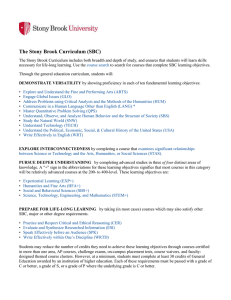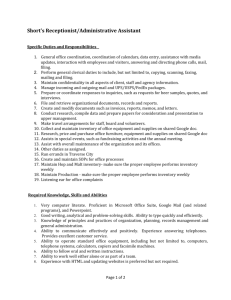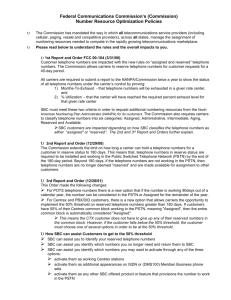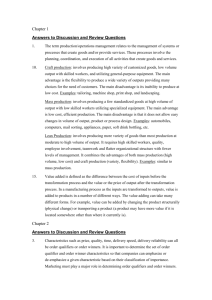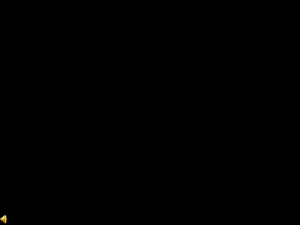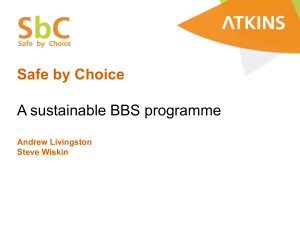Re-measurement of ACS/SBC dark images
advertisement
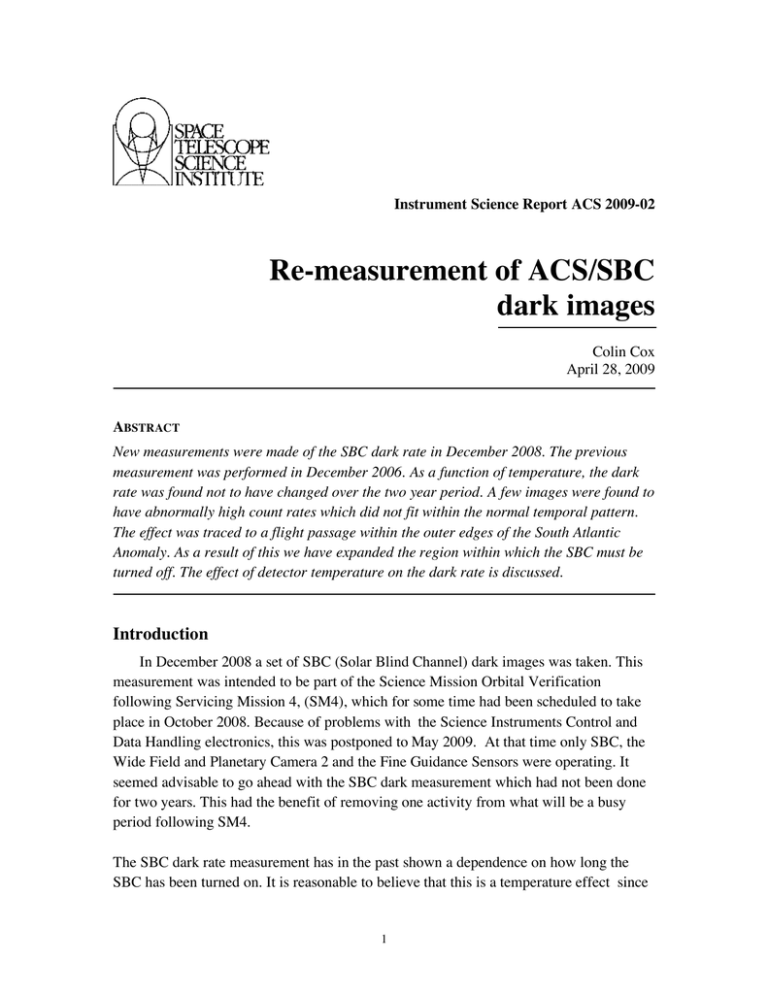
Instrument Science Report ACS 2009-02 Re-measurement of ACS/SBC dark images Colin Cox April 28, 2009 ABSTRACT New measurements were made of the SBC dark rate in December 2008. The previous measurement was performed in December 2006. As a function of temperature, the dark rate was found not to have changed over the two year period. A few images were found to have abnormally high count rates which did not fit within the normal temporal pattern. The effect was traced to a flight passage within the outer edges of the South Atlantic Anomaly. As a result of this we have expanded the region within which the SBC must be turned off. The effect of detector temperature on the dark rate is discussed. Introduction In December 2008 a set of SBC (Solar Blind Channel) dark images was taken. This measurement was intended to be part of the Science Mission Orbital Verification following Servicing Mission 4, (SM4), which for some time had been scheduled to take place in October 2008. Because of problems with the Science Instruments Control and Data Handling electronics, this was postponed to May 2009. At that time only SBC, the Wide Field and Planetary Camera 2 and the Fine Guidance Sensors were operating. It seemed advisable to go ahead with the SBC dark measurement which had not been done for two years. This had the benefit of removing one activity from what will be a busy period following SM4. The SBC dark rate measurement has in the past shown a dependence on how long the SBC has been turned on. It is reasonable to believe that this is a temperature effect since 1 the SBC gets warmer during use and the underlying physical process is temperature dependent. Measurement The measurement, filed as proposal 11885, consisted of 20 dark exposures of 1000 seconds. These took place continuously over a 6-hour period. This way the temporal development of the dark rate could be tracked. The SBC high voltage is normally turned off and the detector temperature is lower than during activation. This measurement ran about as long as any individual observation and so covers a reasonable time and temperature path. Figure 1. The first and last of the series of dark exposures together with profiles of summed columns. The units of the profiles are average counts per pixel within each column for a 1000 second exposure. Figure 1 shows the first and last exposure together with profiles obtained by summing each column of the arrays. The spikes can be traced to a few hot pixels. The mean count 2 rate varies from 9.4 × 10-6 to 2.9 × 10-5 counts per second per pixel, that is by a factor of about 3 as the detector temperature increases from 10ºC to 22ºC over a six-hour period. At the same time the distribution becomes more centrally weighted. The mean number of counts per pixel in 1000 seconds is of order 1/100 so that most pixels will register no counts, about 1% will have 1 count with very few having 2 or more, except for the hot pixels which are excluded from the analysis. Figure 2. Dark count rate as function of time SBC was turned on. In general the count rate increases with time turned on, but two or three of the exposures deviated from the pattern. Figure 2 shows how the count rate varied. The 5th and 6th rates deviate significantly from the general trend. Further investigation showed that the times when these higher rates were measured coincided with passage near the edge of the South Atlantic Anomaly (SAA), a region where a higher than normal rate of charged particle interactions occur. Although the SBC is only intended to be turned on outside this region, the definition of “outside” requires some refinement. The edge of the SAA is not sharply delineated, rather there is a fairly smooth roll off. Figure 3 shows contours of the SAA that have been used to define exclusion zones for various HST instruments. The contour used for the SBC is given the number 28 and is shown in green. Contour 5, shown in blue is used for NICMOS and is at a lower level. The orbits superimposed on the diagram show the parts of the HST path during the dark measurement program. In particular, the segments marked with blue and purple circles correspond to the 5th and 6th exposures, the ones which showed elevated count rates. As a result of these observations, we have 3 Figure 3. South Atlantic Anomaly contours and HST orbits during SBC dark measurement. redefined the SBC SAA contour to match contour 5, so that in future we will not encounter these elevated rates. The SBC dark rate has been measured over several orbits in the past, first soon after the ACS was launched in 2002 and most recently in 2006. Between 2002 and 2006 the dark rate did increase at the higher temperatures. Since then, however, the behaviour has remained stable. Figure 4 compares the count rates as a function of temperature measured in December 2006 and December 2008. Apart from the two anomalously high values, the two sets of measurements track very well. The 2006 measurements extend to slightly higher temperatures. This is because at that time the WFC and HRC were operating. They have been turned off since January 2007 and consequently the environment is about 2.5 degrees cooler. The temperature used for the comparison is not the actual tube temperature with the mnemonic JMTUBET as was used in the past. Instead, a closely related temperature within the associated electronics, JMDECODT has been chosen. The reason for this is that JMTUBET, although available continuously from the engineering data stream, is only reported in the science output when a data dump occurs. While the only ACS 4 camera running is SBC with its 1024 pixel square aperture, the dump occurs only about every five exposures. On the other hand, JMDECODT is reported in the engineering snapshot file along with every exposure. These fies end in _spt.fits and are known as the SPT files. Although JMDECODT is not currently reported in the SPT header, it is not a lot of work to extract it from the SPT image. The number of counts in each image is very low, which is a desirable property for the dark rate, but makes it hard to get good statistics for a dark image. Figure 4 suggests that combining the first five images from 2006 plus images 1,2 3, 6, 7 and 8 from 2008 and smoothing, will provide the best calibration image for the lower temperatures. This could be used for any observations which have the SBC on for less than two hours. Figure 4. Count rate as a function of temperature measured two years apart. For exposures which occur after the SBC has been on for more than two hours, a more accurate dark image can be applied if the temperature is known. Currently the dark image stored in the Calibration Data Base (CDBS) and automatically selected for pipeline processing does not use temperature as a selection key. The dark image provided is that derived from the low temperature average. The sky rate through filters that pass Lyman alpha (F115LP, F122M,PR110L) is normally much larger than the dark rate, even if the latter is higher than usual from higher temperatures. Only a small subset of science, 5 taken through the longer wavelength, narrower filters, and in which the science target count rates are unusually low are likely to benefit from the temperature-dependent darks. Therefore it is reasonable to enable use of this calibration improvement as offline processing. A process is now under way to get the new temperature in the science header. Although we are not planning to have CDBS select dark images by temperature, we will make dark images for the higher temperatures available via the ACS Web page. Figure 5. Raw and smoothed dark image obtained by summing ten images from 2006 and 2008 measured in the low temperature period of each sequence. The dark images shown are formed by summing the first five images from the 2006 measurement and numbers 1,2,3, 6,7 from the 2008 omitting the SAA impacted images. The selection can be understood by referring to Figure 4. The summed image is box-car smoothed with a 51 pixel width to supply the final calibration image. (The horizontal black bar seen is the result of a bad anode in the micro-channel plate and is excluded from all calculations. In the pipeline these are treated as bad pixels. Other hot pixels are similarly excluded.) The mean SBC background rate is very low, of order 10-5 counts a second. This means that for instance, in an exposure of 1000 seconds about 1% of pixels will receive one dark count and almost none will detect more. There will be no dark count in 995 of the pixels. Applying the supplied dark count reference file will subtract a smoothed image with a mean value of about 0.01 counts per pixel. Although statistically this means on average 6 each pixel is closest to its most probable value, it does not well represent the image’s appearance and can easily cause confusion. It would certainly be reasonable to omit the dark count subtraction for all but the longest exposures. The pipeline processing by default performs the subtraction but observations can be reprocessed with the dark subtraction not performed. Acknowledgements I am grateful to Ron Gilliland for discussions concerning the SAA and sky backgrounds. Merle Reinhart provided the informative Figure 3 and has implemented the modifications to the SBC SAA contour References Cox, C., SBC Dark and Cumulative Images, Instrument Science Report ACS 2004014, July 2004. 7
